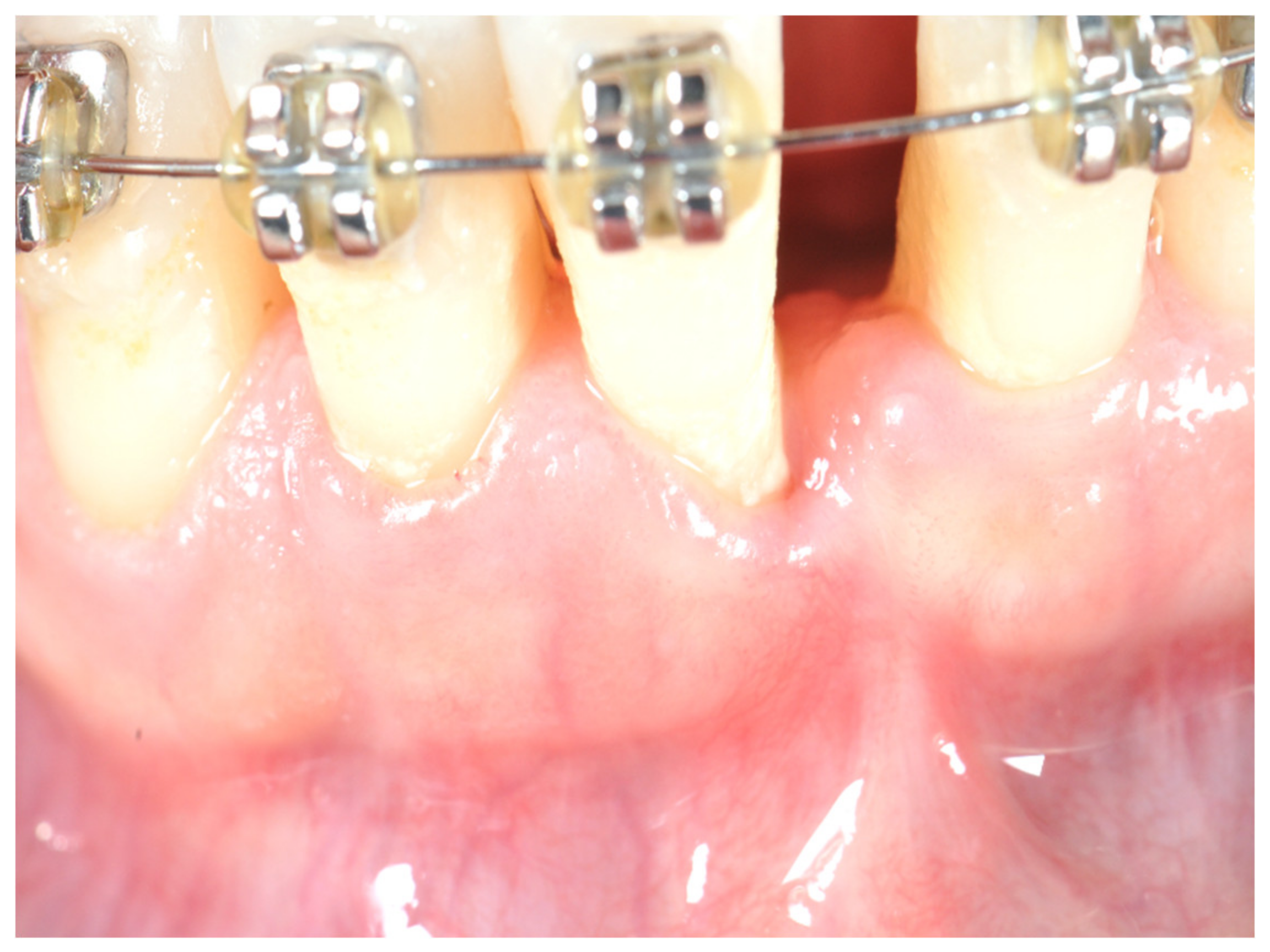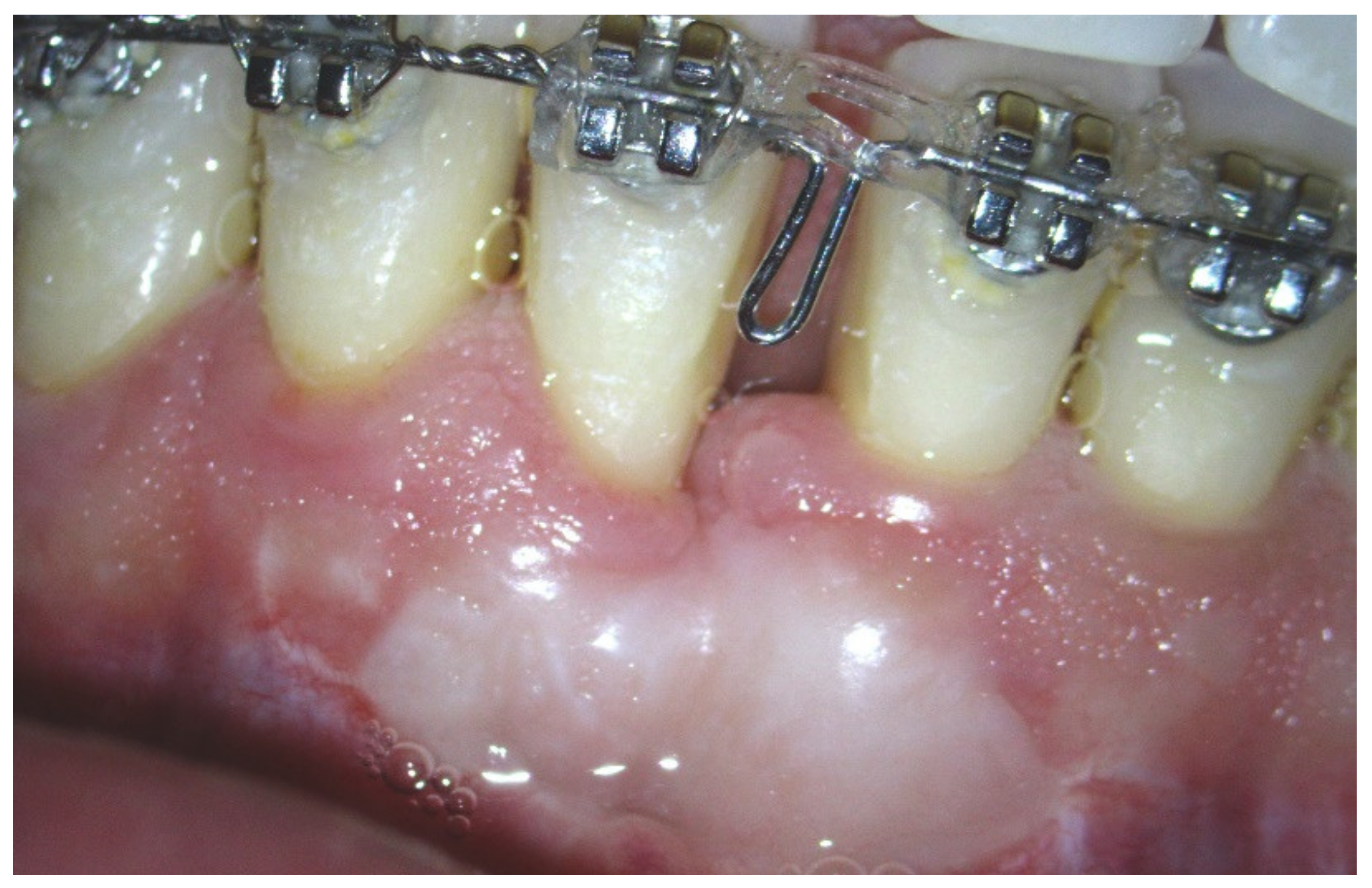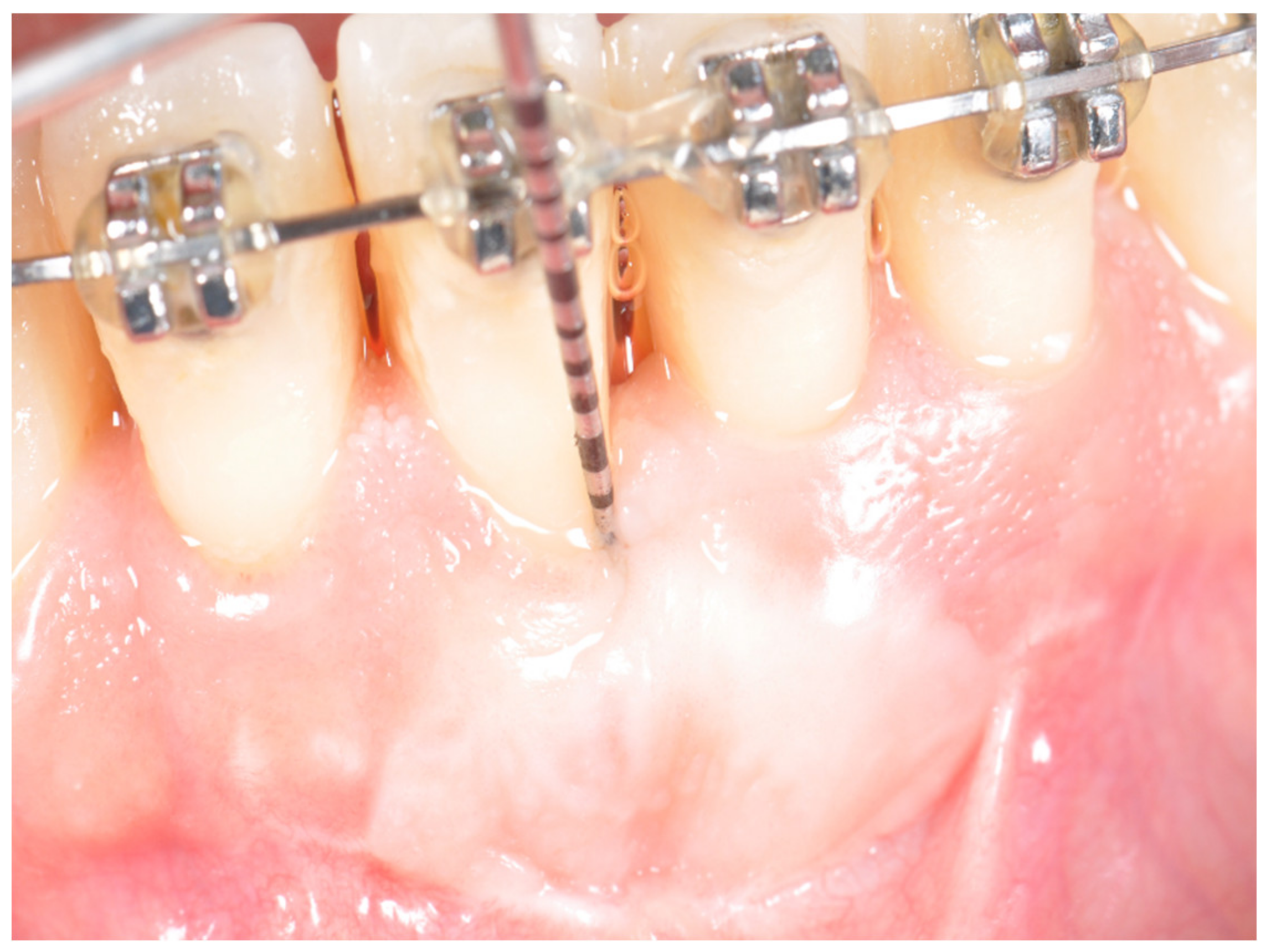Improvement of Periodontal Parameters with the Sole Use of Free Gingival Grafts in Orthodontic Patients: Correlation with Periodontal Indices. A 15-Month Clinical Study
Abstract
1. Introduction
2. Materials and Methods
- Using a #15 blade, an intrasulcular incision was made and a partial thickness flap was raised. The recipient site was prepared by sharp dissection to create a bleeding periosteal bed free of all muscle attachments;
- The resulting flap was excised or sutured at the base of the newly created vestibule with 5-0 plain gut T-mattress sutures (Ethicon, LLC—Johnson and Johnson Co., Guaynabo, Puerto Rico).
- The graft was measured with the probe and its measurements recorded;
- The graft was sutured over the recipient bed with 5-0 absorbable interrupted single sutures (Plain Gut Ethicon, LLC—Johnson and Johnson Co., Guaynabo, Puerto Rico). Where necessary, one or more cross-horizontal mattress sutures were used to ensure the complete stabilization of the graft. The area was then covered with oxidized regenerated cellulose (Tabotamp Ethicon, LLC, city, Johnson and Johnson Co., Guaynabo, Puerto Rico), adhesive dry foil (Burlew Dryfoil Jelenko, Armonk, NY, USA) and periodontal dressing (Coe Pak GC America Inc., Alsip, IL, USA);
- Post-operative instructions were given to all patients. Chlorhexidine 0.12% rinses were prescribed twice a day for two weeks. Anti-inflammatory therapy was prescribed for pain control (Ibuprofen 400 mg b.i.d. for one week);
- Palatal sutures and periodontal dressing were removed at one week; photographs and graft measurements were recorded.
3. Results
4. Discussion
5. Conclusions
Author Contributions
Funding
Acknowledgments
Conflicts of Interest
References
- Lang, N.P.; Löe, H. The relationship between the width of keratinized gingiva and gingival health. J. Periodontol. 1972, 43, 623–627. [Google Scholar] [CrossRef] [PubMed]
- Dorfman, H.S.; Kennedy, J.E.; Bird, W.C. Longitudinal evaluation of free autogenous gingival grafts. J. Clin. Periodontol. 1980, 7, 316–324. [Google Scholar] [CrossRef] [PubMed]
- Dorfman, H.S.; Kennedy, J.E.; Bird, W.C. Longitudinal evaluation of free gingival grafts. A Four-Year Report. J. Clin. Periodontol. 1988, 53, 349–352. [Google Scholar] [CrossRef] [PubMed]
- Wennstrom, J.L.; Lindhe, J. The role of attached gingiva for maintenance of periodontal health. Heal. Follow. Excisional Grafting Proced. Dogs. J. Clin. Periodontol. 1981, 8, 311–328. [Google Scholar] [CrossRef] [PubMed]
- Wennstrom, J.L. Lack of association between width of attached gingiva and development of gingival recessions. A 5-year longitudinal study. J. Clin. Periodontol. 1987, 14, 181–184. [Google Scholar] [CrossRef]
- Johal, A.; Katsaros, C.; Kiliaridis, S.; Leitao, P.; Rosa, M.; Sculean, A.; Weiland, F.; Zachrisson, B. State of the science on controversial topics: Orthodontic therapy and gingival recession (a report of the Angle Society of Europe 2013 meeting). Prog. Orthod. 2013, 14, 16. [Google Scholar] [CrossRef][Green Version]
- Maroso, F.B.; Gaio, E.J.; Rösing, C.K.; Fernandes, M.I. Correlation between gingival thickness and gingival recession in humans. Acta Odontol. 2015, 28, 162–166. [Google Scholar]
- Coatoam, G.W.; Behrents, R.G.; Bissada, N.F. The width of keratinized gingiva during orthodontic treatment: Its significance and impact on periodontal status. J. Periodontol. 1981, 52, 307–313. [Google Scholar] [CrossRef]
- Ward, V.J. A clinical assessment of the use of free gingival graft for correcting localized recession associated with frenal pull. J. Periodontol. 1987, 58, 752–757. [Google Scholar] [CrossRef]
- Han, T.J.; Takei, H.H.; Carranza, F.A., Jr. The strip gingival autograft technique. Int. J. Periodontics Restor. Dent. 1993, 13, 181–190. [Google Scholar]
- Batenhorst, K.F.; Bowers, G.M.; Williams, J.E. Tissue changes resulting from facial tipping and extrusions of incisors in monkeys. J. Periodontol. 1974, 45, 660–668. [Google Scholar] [CrossRef] [PubMed]
- Foushee, D.G.; Moriarty, J.D.; Simpson, D.M. Effects of mandibular orthognathic treatment on mucogingival tissue. J. Periodontol. 1985, 56, 727–733. [Google Scholar] [CrossRef] [PubMed]
- Stetler, K.J.; Bissada, N.B. Significance of the width of keratinized gingiva on periodontal status of teeth with submarginal restorations. J. Periodontol. 1987, 58, 696–700. [Google Scholar] [CrossRef] [PubMed]
- Ericcson, I.; Lindhe, J. Recession in sites with inadequate width of the keratinized gingiva. An experimental study in the dog. J. Clin. Periodontol. 1984, 11, 95–103. [Google Scholar] [CrossRef]
- Sullivan, H.; Atkins, J. Free Autogenous Gingival Grafts. I. Principles of Successful Grafting. J. Periodontol. 1968, 6, 5–11. [Google Scholar]
- Egli, U.; Vollmer, W.H.; Rateitschak, K.H. Follow up studies of free gingival grafts. J. Clin. Periodontol. 1975, 2, 98–104. [Google Scholar] [CrossRef]
- Rateitschak, K.H.; Egli, U.; Fringueli, G. Recession. A 4-year longitudinal study after free gingival grafts. J. Clin. Periodontol. 1979, 6, 158–164. [Google Scholar] [CrossRef]
- Karring, T.; Ostergaard, E.; Löe, H. Conservation of tissue specificity after heterotopic transplantation of gingiva and alveolar mucosa. J. Periodontal. Res. 1971, 6, 282–293. [Google Scholar] [CrossRef]
- De Trey, E.; Bernimoulin, J. Influence of free gingival grafts on the health of the marginal gingiva. J. Clin. Periodontol. 1980, 7, 381–393. [Google Scholar] [CrossRef]
- Hagorsky, U.; Bissada, N.B. Clinical assessment of free gingival grafts effectiveness on maintenance of periodontal health. J. Periodontol. 1980, 51, 274–278. [Google Scholar] [CrossRef]
- Edel, U. Clinical evaluation of free connective tissue grafts used to increase the width of keratinized gingiva. J. Clin. Periodontol. 1974, 1, 185–196. [Google Scholar] [CrossRef] [PubMed]
- Orsini, M.; Orsini, G.; Benlloch, D.; Aranda, J.J.; Lazaro, P.; Sanz, M. Esthetic and dimensional evaluation of free connective tissue grafts in prosthetically treated patients: A 1 year clinical study. J. Periodontol. 2004, 75, 470–477. [Google Scholar] [CrossRef] [PubMed]
- Orsini, M.; Orsini, G.; Benlloch, D.; Aranda, J.J.; Sanz, M. Long-Term Clinical Results on the Use of Bone-Replacement Grafts in the Treatment of Intrabony Periodontal Defects. Comparison of the Use of Autogenous Bone Graft Plus Calcium Sulfate to Autogenous Bone Graft Covered With a Bioabsorbable Membrane. J. Periodontol. 2008, 79, 1630–1637. [Google Scholar] [CrossRef] [PubMed]
- Löe, H.; Silness, P. Periodontal disease in pregnancy. Acta Odontol. Scand. 1963, 21, 533–551. [Google Scholar] [CrossRef] [PubMed]
- Silness, P.; Loe, H. Periodontal disease in Pregnancy. Acta Odontol. Scand. 1964, 22, 121–135. [Google Scholar] [CrossRef] [PubMed]
- Hassel, T.M.; German, M.A.; Saxer, U.P. Periodontal probing: Interinvestigator discrepancies and correlations between probing force and recorded depth. Helv. Odontol. Acta 1973, 17, 38–42. [Google Scholar]
- Davenport, R.H., Jr.; Simpson, D.M.; Hassel, T.M. Histometric comparison of active and inactive lesions of active and inactive periodontitis. J. Periodontol. 1982, 53, 285–295. [Google Scholar] [CrossRef]
- O’Leary, T.J.; Drake, R.B.; Naylor, J.E. The plaque control record. J. Periodontol. 1972, 43, 38–42. [Google Scholar] [CrossRef]
- Broome, W.C.; Taggart, E.J., Jr. Free autogenous connective tissue grafting. J. Periodontol. 1976, 47, 580–585. [Google Scholar] [CrossRef]
- Carranza, F.A., Jr.; Carraro, J.J. Mucogingival techniques in periodontal therapy. J. Periodontol. 1970, 41, 294–299. [Google Scholar] [CrossRef]
- Trott, J.R.; Love, B. An analysis of localized gingival recession in 766 Winnipeg High School students. Dent. Pract. Dent. Rec. 1966, 16, 209–213. [Google Scholar] [PubMed]
- Bernimoulin, J.P.; Schroeder, H.E. Changes in the differentiation pattern of oral mucosal epithelium following heterotopic connective tissue transplantation in man. Pathol. Res. 1980, 166, 290–312. [Google Scholar] [CrossRef]
- Addy, M.; Dummer, P.M.; Hunter, M.L.; Kingdon, A.; Shaw, W.C. A study of the association of frenal attachment, lip coverage, and vestibular depth with plaque and gingivitis. J. Periodontol. 1987, 58, 752–757. [Google Scholar] [CrossRef] [PubMed]
- Steiner, G.G.; Pearson, J.K.; Ainamo, J. Changes of the marginal periodontium as a result of labial tooth movement in monkeys. J. Periodontol. 1981, 52, 314–320. [Google Scholar] [CrossRef]
- Baker, D.L.; Seymour, G.J. The possible pathogenesis of gingival recession. A histological study of induced recession in the rat. J. Clin. Periodontol. 1976, 3, 208–2019. [Google Scholar] [CrossRef] [PubMed]
- Melsen, B.; Allais, D. Factors of importance for the development of dehiscences during labial movement of mandibular incisors: A retrospective study of adult orthodontic patients. Am. J. Orthod. Dentofac. Orthop. 2005, 127, 552–561. [Google Scholar] [CrossRef]
- Yared, K.F.G.; Zenobio, E.G.; Pacheco, W. Periodontal status of mandibular central incisors after orthodontic proclination in adult. Am. J. Orthod Dentofac. Orthop. 2006, 130, 1–8. [Google Scholar] [CrossRef]
- Cheng, H.C.; Hu, H.T.; Chang, Y.C. Effectiveness of Enzyme Dentifrices on Oral Health in Orthodontic Patients: A Randomized Controlled Trial. Int. J. Environ. Res. Public Health 2019, 25, 2243. [Google Scholar] [CrossRef]
- Sfondrini, M.F.; Debiaggi, M.; Zara, F.; Brerra, R.; Comelli, M.; Bianchi, M.; Pollone, S.R.; Scribante, A. Influence of lingual bracket position on microbial and periodontal parameters in vivo. J. Appl. Oral Sci. 2012, 20, 357–361. [Google Scholar] [CrossRef]




| Patients | |
|---|---|
| Age (Years), Mean ± SD (Range) | 41 ± 6.8 (30–52) |
| Sex (Female/Male) | 11/9 |
| Smokers | None |
| Sites | |
| Anterior/Posterior | 19/0 |
| Maxilla/Mandible | 0/19 |
| No. | Gingival Index | Plaque Index | ||||||
|---|---|---|---|---|---|---|---|---|
| T0 | T1 | T2 | T3 | T0 | T1 | T2 | T3 | |
| 1 | 1 | 2 | 1 | 1 | 1 | 2 | 1 | 1 |
| 2 | 1 | 1 | 1 | 1 | 1 | 2 | 1 | 1 |
| 3 | 0 | 2 | 1 | 1 | 1 | 2 | 1 | 1 |
| 4 | 1 | 2 | 0 | 0 | 1 | 3 | 1 | 1 |
| 5 | 1 | 1 | 0 | 0 | 1 | 1 | 1 | 1 |
| 6 | 1 | 2 | 0 | 1 | 1 | 2 | 1 | 1 |
| 7 | 1 | 1 | 0 | 0 | 1 | 1 | 1 | 1 |
| 8 | 1 | 2 | 1 | 1 | 1 | 2 | 1 | 1 |
| 9 | 1 | 2 | 0 | 1 | 1 | 2 | 1 | 1 |
| 10 | 2 | 2 | 0 | 0 | 2 | 2 | 1 | 1 |
| 11 | 1 | 1 | 0 | 1 | 1 | 2 | 0 | 0 |
| 12 | 0 | 1 | 0 | 0 | 1 | 1 | 1 | 1 |
| 13 | 2 | 2 | 1 | 1 | 2 | 2 | 1 | 1 |
| 14 | 1 | 1 | 0 | 0 | 1 | 1 | 0 | 1 |
| 15 | 1 | 2 | 0 | 1 | 1 | 2 | 1 | 2 |
| 16 | 0 | 1 | 1 | 1 | 1 | 2 | 1 | 1 |
| 17 | 2 | 2 | 0 | 1 | 2 | 1 | 0 | 0 |
| 18 | 1 | 2 | 1 | 1 | 1 | 2 | 1 | 1 |
| 19 | 2 | 1 | 0 | 0 | 1 | 2 | 1 | 1 |
| MEAN | 1.05 | 1.58 | 0.37 | 0.63 | 1.16 | 1.79 | 0.84 | 0.95 |
| SD | 0.62 | 0.51 | 0.50 | 0.50 | 0.37 | 0.54 | 0.37 | 0.40 |
| Mean Differences (SD) | ||||||||
| Gingival Index | Plaque Index | |||||||
| T1–T0 | T2–T0 | T2–T1 | T3–T1 | T1–T0 | T2–T0 | T2–T1 | T3–T1 | |
| Mean | −0.53 | 0.68 | 1.21 | 0.95 | −0.63 | 0.32 | 0.95 | 0.84 |
| SD | 0.70 | 0.89 | 0.63 | 0.52 | 0.68 | 0.58 | 0.52 | 0.60 |
| P * | 0.007 | 0.006 | <0.001 | <0.001 | 0.002 | 0.03 | <0.001 | <0.001 |
| % of Subjects with 1 Unit Score Decrease | ||||||||
| T1–T0 | T2–T0 | T2–T1 | T1–T0 | T2–T0 | T2–T1 | |||
| O.O | 58.3 | 91.7 | 0.0 | 16.7 | 75.0 | |||
| PPD | P * | CAL | P * | Graft Width | P * | |
|---|---|---|---|---|---|---|
| Mean (SD) | ||||||
| T0–Baseline | 2.26 (0.65) | 2.58 (1.02) | ||||
| T1–Preintervention | 2.52 (0.51) | 2.74 (0.99) | 9.25 (2.09) | |||
| T2–3 Months Postintervention | 2.75 (0.87) | 2.83 (1.40) | 6.42 (1.62) | |||
| T3–15 Months Postintervention | 2.63 (0.76) | 3.00 (1.15) | ||||
| Mean Differences (SD) | ||||||
| T1–T0 | 0.33 (0.78) | 0.2 | 0.16 (0.83) | 0.3 | ||
| T2–T0 | 0.42 (0.79) | 0.1 | 0.25 (0.62) | 0.2 | ||
| T2–T1 | 0.08 (0.67) | 0.7 | 0.17 (0.58) | 0.3 | −2.83 (1.03) | 0.002 |
| T3–T0 | 0.37 (0.76) | 0.054 | 0.42 (0.69) | 0.019 | ||
| T3–T1 | 0.11 (0.66) | 0.5 | 0.26 (0.65) | 0.1 | −3.32 (1.20) | <0.001 |
© 2020 by the authors. Licensee MDPI, Basel, Switzerland. This article is an open access article distributed under the terms and conditions of the Creative Commons Attribution (CC BY) license (http://creativecommons.org/licenses/by/4.0/).
Share and Cite
Orsini, M.; Benlloch, D.; Aranda Macera, J.J.; Flores, K.; Ríos-Santos, J.-V.; Pedruelo, F.J.; Ríos-Carrasco, B.; di Cesare, M. Improvement of Periodontal Parameters with the Sole Use of Free Gingival Grafts in Orthodontic Patients: Correlation with Periodontal Indices. A 15-Month Clinical Study. Int. J. Environ. Res. Public Health 2020, 17, 6578. https://doi.org/10.3390/ijerph17186578
Orsini M, Benlloch D, Aranda Macera JJ, Flores K, Ríos-Santos J-V, Pedruelo FJ, Ríos-Carrasco B, di Cesare M. Improvement of Periodontal Parameters with the Sole Use of Free Gingival Grafts in Orthodontic Patients: Correlation with Periodontal Indices. A 15-Month Clinical Study. International Journal of Environmental Research and Public Health. 2020; 17(18):6578. https://doi.org/10.3390/ijerph17186578
Chicago/Turabian StyleOrsini, Marco, Dunia Benlloch, Juan José Aranda Macera, Karina Flores, José-Vicente Ríos-Santos, Francisco Javier Pedruelo, Blanca Ríos-Carrasco, and Massimo di Cesare. 2020. "Improvement of Periodontal Parameters with the Sole Use of Free Gingival Grafts in Orthodontic Patients: Correlation with Periodontal Indices. A 15-Month Clinical Study" International Journal of Environmental Research and Public Health 17, no. 18: 6578. https://doi.org/10.3390/ijerph17186578
APA StyleOrsini, M., Benlloch, D., Aranda Macera, J. J., Flores, K., Ríos-Santos, J.-V., Pedruelo, F. J., Ríos-Carrasco, B., & di Cesare, M. (2020). Improvement of Periodontal Parameters with the Sole Use of Free Gingival Grafts in Orthodontic Patients: Correlation with Periodontal Indices. A 15-Month Clinical Study. International Journal of Environmental Research and Public Health, 17(18), 6578. https://doi.org/10.3390/ijerph17186578






